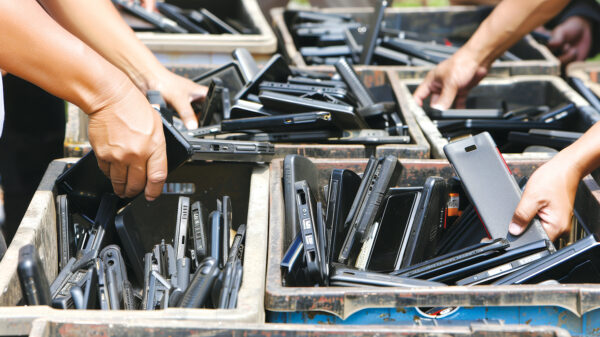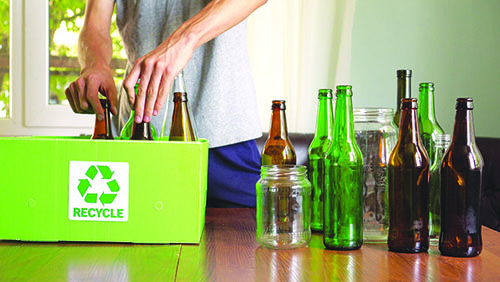by MAURA KELLER
Technological innovations and technically-advanced processes are fast becoming the core backbone of today’s waste and recycling industries.

Matanya Horowitz, founder and chief executive officer at AMP said two trends they’re watching with regard to waste technology are larger deployments of artificial intelligence (AI) and robotics technology and new applications of AI.
In terms of larger deployments of AI and robotics, more materials recovery facilities (MRFs) have adopted and begun to rely on automation in the last few years, but especially so during the pandemic as a path to operational continuity.
“The pandemic accelerated adoption and greater interest in larger and repeat orders, but it wouldn’t have happened without increasing acceptance of AI and robotics,” Horowitz said. “Thanks to continuous improvements in field performance and reliability, AI-guided robotics systems have become proven technologies. These larger deals validate their ability to help the industry enhance safety, increase productivity, and improve recovered resource quality.”
What’s more, AI improvements have paved the way for the expansion of categories for identification by material type, form factor, and numerous other attributes. These advancements create new opportunities for applications like waste auditing and characterization, providing much-needed data and bringing greater transparency to the material stream.
According to Dan Kurtz, vice president of recycling for Waste Connections, who AMP has partnered with to deploy 24 systems, this technology “is giving us real-time data on what’s going past the robots. We see everything. We can tell how much cardboard or paper is in a plastics stream, down to the brand level. It’s also giving us a way to collaborate with brand owners and packaging producers and get a heads up on what’s coming before it ever hits the market. This provides the opportunity to go after polypropylene, which is becoming more prevalent, because robots can identify the material in a split second.”
According to Kevin Garcia, general manager of civil specialty solutions at Trimble, provider of a wide range of hardware and software solutions for the waste industry, including for weighing, transfer and landfill management, the industry is seeing a push toward technology solutions that can help eliminate inefficiencies all across the waste stream. For example, any landfill truck scale operator can tell you that most garbage trucks are significantly underloaded, and a landfill without proper management is a problem.
“Onboard scale technology can solve both problems by helping monitor and provide actionable data about the waste stream,” Garcia said.
Technology also allows landfill operators to construct new cells efficiently and accurately. As Garcia explained, machine control systems enable operators to place refuse within the permitted airspace and compact it completely, while maintaining grade aid with water runoff.
“Compacting material completely means that machines move more efficiently, using less fuel and reducing maintenance issues,” Garcia said. Drones allow landfill operators to measure their landfill sites accurately and with little effort, which enables informed decision making.
New technology can have significant impacts on the industry. In addition to increasing efficiency, technology can also provide data that enables better decision-making across a waste management organization. For example, onboard scales optimize payload on every dumpster, but new reporting tools go even further to help optimize profitability per route or per customer, which puts the hauler in control of profitability. Similarly, as Garcia explained, drones give landfill operators a snapshot in time that can be used for measuring airspace, density, surface area and slope, all of which can be used to make better decisions.
With new technologies comes new challenges. As Horowitz explained, the economics and efficiency of identifying and sorting paper, plastics, metals, and other recyclables from the waste stream creates a major challenge for material recovery.
In recent years, the waste industry has also faced stricter international quality standards for contamination-free imports of recycled materials, leaving the industry in search of cost-effective alternatives to meet these requirements.
“COVID-19 then forced many businesses to suspend recycling operations due to concerns for worker safety,” Horowitz said. “Simultaneously, the pandemic increased demand for high-quality recycled feedstock to overcome supply chain interruptions and shifts in raw material availability.”
AI and robotics technology is helping the waste industry meet these challenges by modernizing recycling – improving material quality, ensuring worker safety, increasing productivity, lowering costs, diverting waste from landfill, and reducing greenhouse gas emissions – while increasing overall rates of recycling and resource recovery.
“The expansion of AI applications for material identification and recovery is a major focus for the future,” Horowitz said. AMP is developing new vision system offerings, innovating data capture for waste characterization to support operators, and expanding data access to packaging producers to help them achieve recycled content goals.
“AI opens up opportunities that make recycling a more important part of the waste ecosystem,” Horowitz said.
COVID-19 shifting the waste stream from commercial to residential has highlighted the need for those in the waste management sector to be able to pivot quickly. “Accurate real-time waste stream data using accurate sensors like onboard truck scales unlocks opportunities to improve profitability,” Garcia said. “Landfill consents close to the waste source are more challenging, so we need to do more with the landfill resources we have.”
Another challenge that Garcia pointed to is a shortage of skilled, technologically savvy people interested in waste management careers. Landfills are getting big enough that small improvements in efficiency can have big financial gain, but the technology must both provide value to field operations and be easy to use and learn without extensive training.
“Our drone mapping and machine indicate systems, for example, are purpose-built to be user-friendly, easy to implement, and to drive value,” Garcia said. “Technology must meet all three of these criteria in order to take hold in the waste management sector.”
Technology Innovations & Landfills
One area of the waste management industry that has received increased focus is within the landfill environment – specifically as it relates to the transformation of landfills and landfill gas. There has been a shift in focus from the use of landfill gas as fuel to create electricity in favor of using it as a raw feedstock to create Renewable Natural Gas (RNG).
One of the biggest challenges faced by waste management companies today is how they present themselves as “green” and environmentally friendly, especially in a political climate that has made sustainability a cornerstone of the new administration’s agenda.
“By voluntarily implementing RNG projects, waste management companies are able to show the local communities how they are materially impacting the environment in a positive way,” said Michael Bakas, executive vice president at Ameresco. “This voluntary act will go a long way with local governments, permitting agency and the community.
This RNG technology being utilized within landfills is a more efficient use of the renewable fuel and has an effective way to decarbonize the natural gas grid and the traditional use of natural gas as well as the transportation sector,” Bakas said. “We’re also seeing a push to organics from landfills, especially in more progressive states, which increase the cost of disposal, create a need to find ways to safely treat this waste and will negatively impact the generation of landfill gas at the landfills.” Ameresco is a leading, diverse clean technology integrator with a comprehensive portfolio of energy efficiency and renewable energy supply solutions.
In general, the U.S. has experienced a tremendous amount of focus by many on “going green” initiatives. The move toward a low-carbon economy continues to gain momentum. Primarily state policymakers are working to formulate a comprehensive U.S. energy policy that addresses climate change, security of supply and affordability within a framework that supports the transition to a low-carbon future.
As Bakas explained, business leaders are considering sustainable growth strategies and integrating sustainability in the way they manage their businesses.
“Corporations bought a record amount of clean energy in 2019 – up more than 40 percent from the previous year’s record with most of this purchasing occurring in the U.S. In addition, many organizations are being pushed to address their carbon risk exposure by shareholders,” Bakas said.
But, with great progress made addressing the “electric side” of the carbon footprint, organizations are now turning to the thermal side of the equation. This is where the benefits of RNG come into play.
“RNG is an ultra-clean and ultra-low carbon natural gas alternative that can help end users reduce their Scope 1 Emissions on a one-for-one basis –something that most other renewable fuels cannot do for the thermal side,” Bakas said. “Given the Biden Administration’s interest in hydrogen and carbon sequestration, it would seem logical that visibility into this market will drive investment into advancing technology in order to spur the growth in this sector – possibly using renewable natural gas as feedstock for these projects.
Published in the March 2021 Edition







